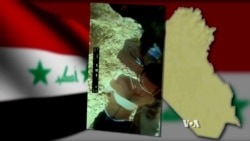Expertly produced videos of beheadings, executions, people being thrown off buildings – these are images the Islamic State has used to hone its reputation as the most brutal of terror organizations. But also lurking online are hundreds more equally brutal videos, meant to outdo those of the Islamic State.
"Shia militias have deliberately pushed out very brutal images and a lot of really nasty things," said Phillip Smyth, a University of Maryland researcher who specializes in Iraq’s militia activity. "Since about fall of 2014, there’s been a real upsurge in terms of quite, quite brutal imagery."
In many cases, all it takes in a mobile phone.
"Fighters are taking this imagery and putting it up," Smyth said. "They wish to kind of demonstrate that they can be tough and just as brutal as the ISIS people and they’re not messing around."
One of the most disturbing of these videos is that of a Sunni boy, accused of working with the Islamic State. He is on his knees, his hands are bound behind his back, as armed men raise their machine guns, shooting him in the head.
In another video, two men are forced to their knees next to a pile of motionless and bloody bodies. As in the first video, they are accused of helping the Islamic State. They are shot and beaten and shot again.
Other videos show men in military gear celebrating after a civilian is beheaded or even as a man’s head is being cut off, a banner with a picture of a Shia saint in the background.
Videos hard to authenticate
The videos are difficult to authenticate, many done in such a way that it can be difficult, if not impossible, to determine when or where the events took place. And while new videos are being posted constantly, old videos are also recycled.
Analysts who spoke to VOA say despite the questions, the videos do appear to show the perpetrators are Shia, whether they are with the Iraqi military or with militias, as evidenced by the chants they sing, the banners they use or because of the social media accounts posting the material.
More difficult to determine is whether the victims in these videos actually have any real connection with the Islamic State.
"You can’t really tell if these people were ISIS members," said Smyth, using an acronym for the would-be caliphate. "Many of these groups were involved in nasty sectarian bloodletting for many years."
Rights abuses cited
U.S. officials say the videos are "obviously very concerning."
On Thursday, State Department spokeswoman Jen Psaki said allegations of human rights abuses had already caused the U.S. to withhold assistance for some Iraqi military units.
"There are laws in place that have been in place for some time that we have applied to some Iraqi units and certainly we would continue to apply those if applicable," she said. "Their behavior must be beyond reproach or they risk being painted with the same brush as ISIL fighters."
But analysts argue, in many cases, that is exactly what the Shia forces want.
"Now there’s a way to project within the Shia community and say, well, we’re strong and we’re tough and we’re so tough, we’re going to do the same exact things that they tried to do to us and we’re going to show them," Smyth said.
Iraqi Prime Minister Haider al-Abadi on Thursday again called for restraint from all forces fighting against the Islamic State, decrying the presence of "infiltrators who want to tarnish our victories by committing crimes and serious violations against the security and property of people."
Bloody boasts
But even if his repeated calls resonate with Iraqi forces, many of the Shia militias answer to Iran. Analysts say Tehran so far has shown little inclination to push back against the spread of such graphic images.
The allure of social media – with constant posts and status updates, combined with the availability of mobile phones – also poses a challenge.
While taking video of beatings, beheadings and other atrocities may seem repulsive to many in the West, for individuals on the ground, it’s a quick and easy way to snap a war trophy – or to build an online resume.
"If I’m a guy who wants to join a militia, there’s a strong possibility that I want to get a shot," said Smyth. "I want to show that I showed ISIS something, 'Hey, what did you do? I have a picture.'"









